Study on the Impact of Spontaneous Combustion of Coal Gangue on Photovoltaic Pile Foundations and Surface Structures
Abstract
:1. Introduction
2. Model Development
2.1. Modeling Basis for the Temperature Field and Fundamental Assumptions
2.2. Geometric Model Development
2.3. Basic Equations for Model Calculations
2.4. Model Comparison Validation
3. Effect of Gangue Spontaneous Combustion on the Gangue Surface
4. Mechanism of Gangue Spontaneous Combustion on Pile Foundation
4.1. Temperature Distribution
4.2. Thermal Stress Variation in the Pile Shaft
4.3. Displacement
4.4. Variation in Pile Shaft Strain
5. Conclusions
- The self-heating and oxidation of coal gangue result in continuous temperature increases. During the early stages of spontaneous combustion, due to better ventilation conditions along the slopes, high-temperature regions first appear beneath the slope surfaces. Initially, the gangue pile experiences a rapid temperature rise, followed by a slower and stabilized rate of increase. Over time, high-temperature zones gradually expand toward the interior.
- The high temperatures generated by spontaneous combustion cause thermal expansion of the pile materials, leading to thermal stress within the pile. The variation trend of thermal stress in the pile corresponds closely with the temperature evolution. Due to pile–soil interactions, thermal stress is highest at the pile–soil interface and near the pile tip. Over time, the accumulated thermal effects from spontaneous combustion result in increasing strain, with maximum pile displacement reaching approximately 3.5 mm. These changes may compromise the stability and load-bearing capacity of the pile, increasing the risk of structural failure.
- Spontaneous combustion increases the porosity and permeability of the gangue pile, reducing its overall strength. Simulation results indicate that the displacement is most significant at the top of the gangue pile, especially in high-temperature regions. If not properly controlled, long-term cumulative displacement could compromise slope stability and potentially lead to landslides and other geological hazards.
Author Contributions
Funding
Data Availability Statement
Conflicts of Interest
References
- Li, M.D.; Li, J.W. Development status and outlook of distributed photovoltaic power generation in China under the ‘dual-carbon’ target. Sol. Energy 2023, 5–10. (In Chinese) [Google Scholar] [CrossRef]
- Guo, Y.X.; Zhang, Y.Y.; Cheng, F.Q. Industrialization of comprehensive utilization of coal gangue and its outlook. J. Chem. Eng. 2014, 65, 2443–2453. (In Chinese) [Google Scholar]
- Guan, J.; Li, Y.S. Current situation and the prospect of comprehensive utilization of coal gangue. Environ. Sustain. Dev. 2008, 1, 34–36. [Google Scholar]
- Bi, Y.L.; Quan, Q.Z. Environmental problems of coal gangue piling and its bio-integrated management measures. Met. Mine 2005, 354, 61–64. [Google Scholar]
- Liu, Y.G.; Yu, L.N.; Wang, H.C. Study on countermeasures of coal gangue pollution prevention and regional sustainable development in China. Appl. Mech. Mater. 2013, 307, 510–513. [Google Scholar] [CrossRef]
- Fan, J.Y.; Liu, P.; Li, J.J.; Jiang, D.Y. A coupled methane/airflow model for coal gas drainage: Model development and finite-difference solution. Process Saf. Environ. Prot. 2020, 141, 288–304. [Google Scholar] [CrossRef]
- Liu, A.; Liu, P.; Liu, S. Gas diffusion coefficient estimation of coal: A dimensionless numerical method and its experimental validation. Int. J. Heat Mass Transf. 2020, 162, 120336. [Google Scholar] [CrossRef]
- Fabiańska, M.J.; Ciesielczuk, J.; Kruszewski, Ł.; Misz-Kennan, M.; Blake, D.R.; Stracher, G.; Moszumańska, I. Gaseous compounds and efflorescences generated in self-heating coal-waste dumps—A case study from the Upper and Lower Silesian Coal Basins (Poland). Int. J. Coal Geol. 2013, 116, 247–261. [Google Scholar] [CrossRef]
- Jia, B.S. Research on Mathematical Model and Prevention Technology of Natural Fire in Gangue Mountain. Master’s Thesis, Liaoning University of Engineering and Technology, Fuxin, China, 2002. (In Chinese). [Google Scholar]
- Zhang, Y.; Zhang, Y.; Shi, X.; Li, Y.; Zhang, X. Co-spontaneous combustion of coal and gangue: Thermal behavior, kinetic characteristics and interaction mechanism. Fuel 2022, 315, 123275. [Google Scholar] [CrossRef]
- Deng, J.; Xu, J.; Wang, H.Q. Numerical simulation study on natural ignition test bed of cylindrical coal. J. Liaoning Univ. Eng. Technol. (Nat. Sci. Ed.) 2002, 129–132. (In Chinese) [Google Scholar] [CrossRef]
- Deng, J.; Xiao, Y.; Li, Q.; Lu, J.; Wen, H. Experimental studies of spontaneous combustion and anaerobic cooling of coal. Fuel 2015, 157, 261–269. [Google Scholar] [CrossRef]
- Ozdeniz, A.H.; Corumluoglu, O.; Kalayci, I.; Sensogut, C. 3.5 D Temperature Model of a Coal Stockpile. Energy Sources Part A 2008, 30, 1085–1097. [Google Scholar] [CrossRef]
- Liu, X.; Liang, C.; Qian, J.; Li, X.; Li, X.; Li, B.; Xu, G.; Zhou, B. Research on wireless monitoring system for internal temperature field of coal gangue mountain. Case Stud. Therm. Eng. 2025, 66, 105742. [Google Scholar] [CrossRef]
- Zhou, X.; Guo, L.; Zhang, Y.; Wang, Z.; Ma, Y.; Li, X. Feasibility investigation of utilizing spontaneous combustion energy of abandoned coal gangue by constructing a novel artificial heat reservoir. J. Clean. Prod. 2022, 373, 133948. [Google Scholar] [CrossRef]
- Li, A.; Chen, C.; Chen, J.; Lei, P.; Zhang, Y. Experimental investigation of temperature distribution and spontaneous combustion tendency of coal gangue stockpiles in storage. Environ. Sci. Pollut. Res. 2021, 28, 34489–34500. [Google Scholar] [CrossRef]
- Zhu, H.-q.; Song, Z.-y.; Tan, B.; Hao, Y.-z. Numerical investigation and theoretical prediction of self-ignition characteristics of coarse coal stockpiles. J. Loss Prev. Process Ind. 2013, 26, 236–244. [Google Scholar] [CrossRef]
- Wu, Y.; Yu, X.; Hu, S.; Shao, H.; Liao, Q.; Fan, Y. Experimental study of the effects of stacking modes on the spontaneous combustion of coal gangue. Process Saf. Environ. Prot. 2019, 123, 39–47. [Google Scholar] [CrossRef]
- Wang, P.; Yang, S.; Wang, W.; Cao, Z.; Cao, Y. A study on the thermal behavior of coal gangue mountains under airflow influence based on MD and CFD simulations. Int. J. Hydrogen Energy 2024, 93, 788–804. [Google Scholar] [CrossRef]
- Liu, Y.; Qi, X.; Luo, D.; Zhang, Y.; Qin, J. Detection of spontaneous combustion areas of coal gangue mountains and comprehensive governance technologies: A case study. ACS Omega 2023, 8, 47690–47700. [Google Scholar] [CrossRef]
- Zhao, N.; Zhang, Y.; Zhao, X.; Yang, N.; Wang, Z.; Guo, Z.; Tong, J.; Zhang, Y.; Liu, Z. Temperature Distribution Regularity and Dynamic Evolution of Spontaneous Combustion Coal Gangue Dump: Case Study of Yinying Coal Mine in Shanxi, China. Sustainability 2023, 15, 6362. [Google Scholar] [CrossRef]
- Bai, G. Study on Thermodynamic Characteristics and Heat Transfer Method of Uncontrolled Fire in Coal Mine Gangue Mountain Spontaneous Combustion Based on System Dynamics. Comput. Intell. Neurosci. 2022, 2022, 5953322. [Google Scholar] [CrossRef] [PubMed]
- Zhang, Y.; Zhang, Y.; Shi, X.; Liu, S.; Shu, P.; Xia, S. Investigation of thermal behavior and hazards quantification in spontaneous combustion fires of coal and coal gangue. Sci. Total Environ. 2022, 843, 157072. [Google Scholar] [CrossRef] [PubMed]
- Lu, Y. Research on the Spontaneous Combustion Characteristics and Temperature Field Distribution Law of Gangue Mountain. Master’s Thesis, Inner Mongolia University of Science and Technology, Baotou, China, 2021. (In Chinese). [Google Scholar]
- Ejlali, A.; Mee, D.; Hooman, K.; Beamish, B. Numerical modelling of the self-heating process of a wet porous medium. Int. J. Heat Mass Transf. 2011, 54, 5200–5206. [Google Scholar] [CrossRef]
- Yang, N. Research on the Temperature Distribution and Dynamic Evolution Law of Spontaneous Gangue Mountain in Yinying Coal Mine. Master’s Thesis, Taiyuan University of Technology, Taiyuan, China, 2021. (In Chinese). [Google Scholar]
- Li, X.; Sun, W.; Yang, Z. Numerical simulation of the dynamic change law of spontaneous combustion of coal gangue mountains. ACS Omega 2022, 7, 37201–37211. [Google Scholar] [CrossRef]
- Duan, Y.L.; Zhou, X.G.; Yu, M.G.; Wu, C.H.; Hao, Q. Correlation analysis of spontaneous combustion degree and explosion in gangue mountain. J. Coal 2009, 34, 514–519. (In Chinese) [Google Scholar]
- Jiang, C.; Zeng, Y.; Deng, B.; Wang, C.; Sun, Q.; Liu, P.; Li, L. Mechanisms underlying variations in pore structures and permeability in response to thermal treatment and their implications for underground coal utilization. Powder Technol. 2024, 444, 120073. [Google Scholar] [CrossRef]
- Di Donna, A.; Loria, A.F.R.; Laloui, L. Numerical study of the response of a group of energy piles under different combinations of thermo-mechanical loads. Comput. Geotech. 2016, 72, 126–142. [Google Scholar] [CrossRef]
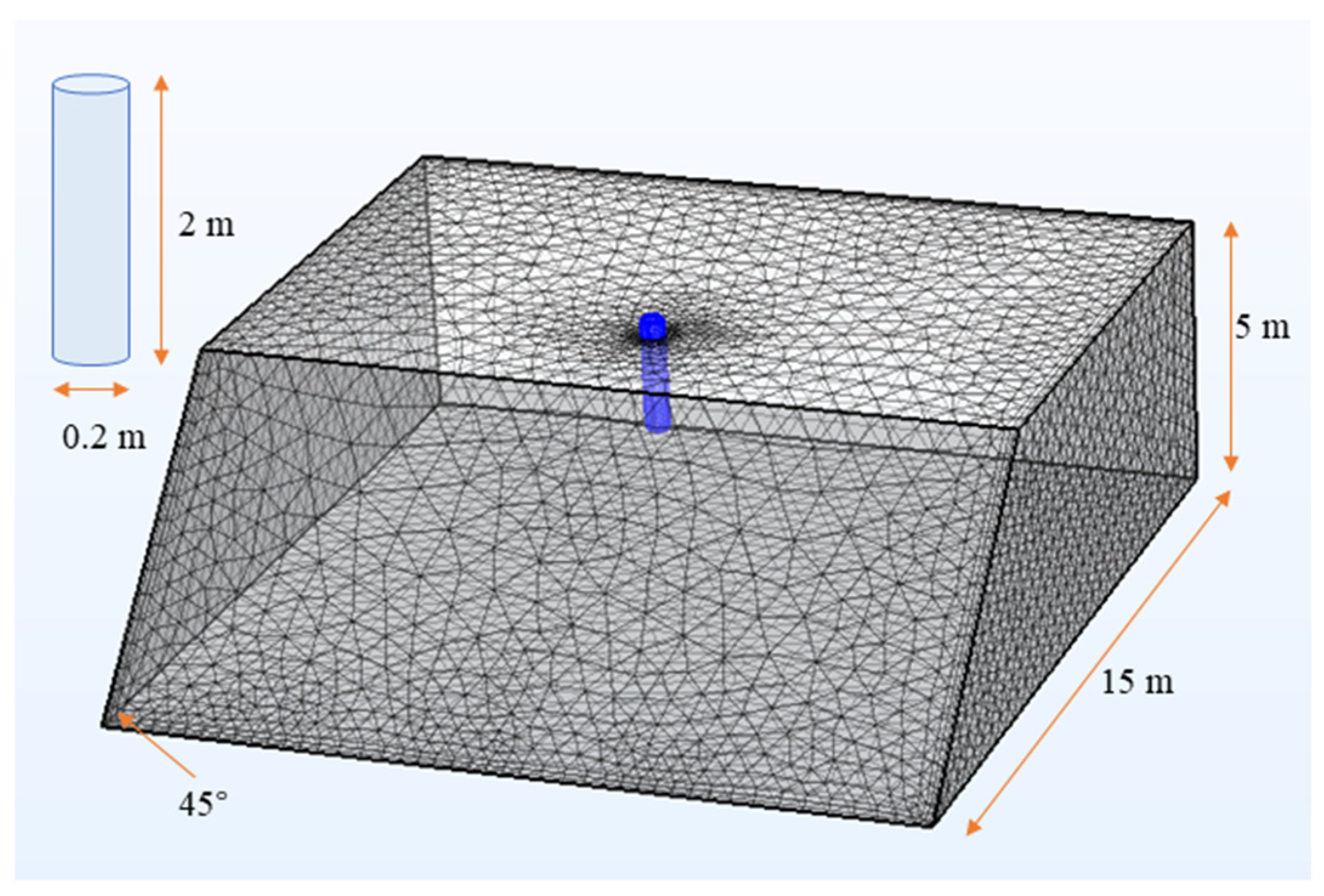
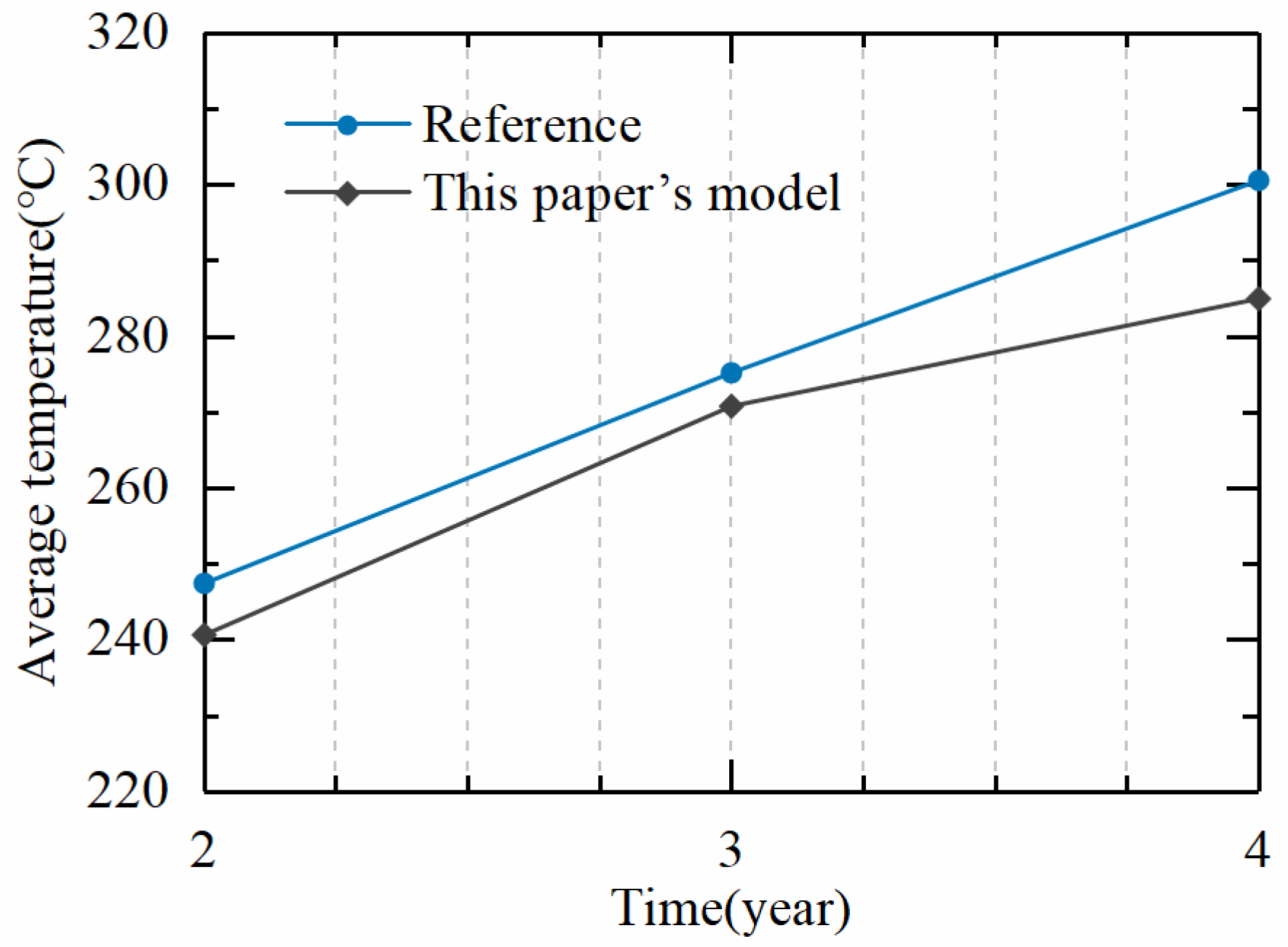

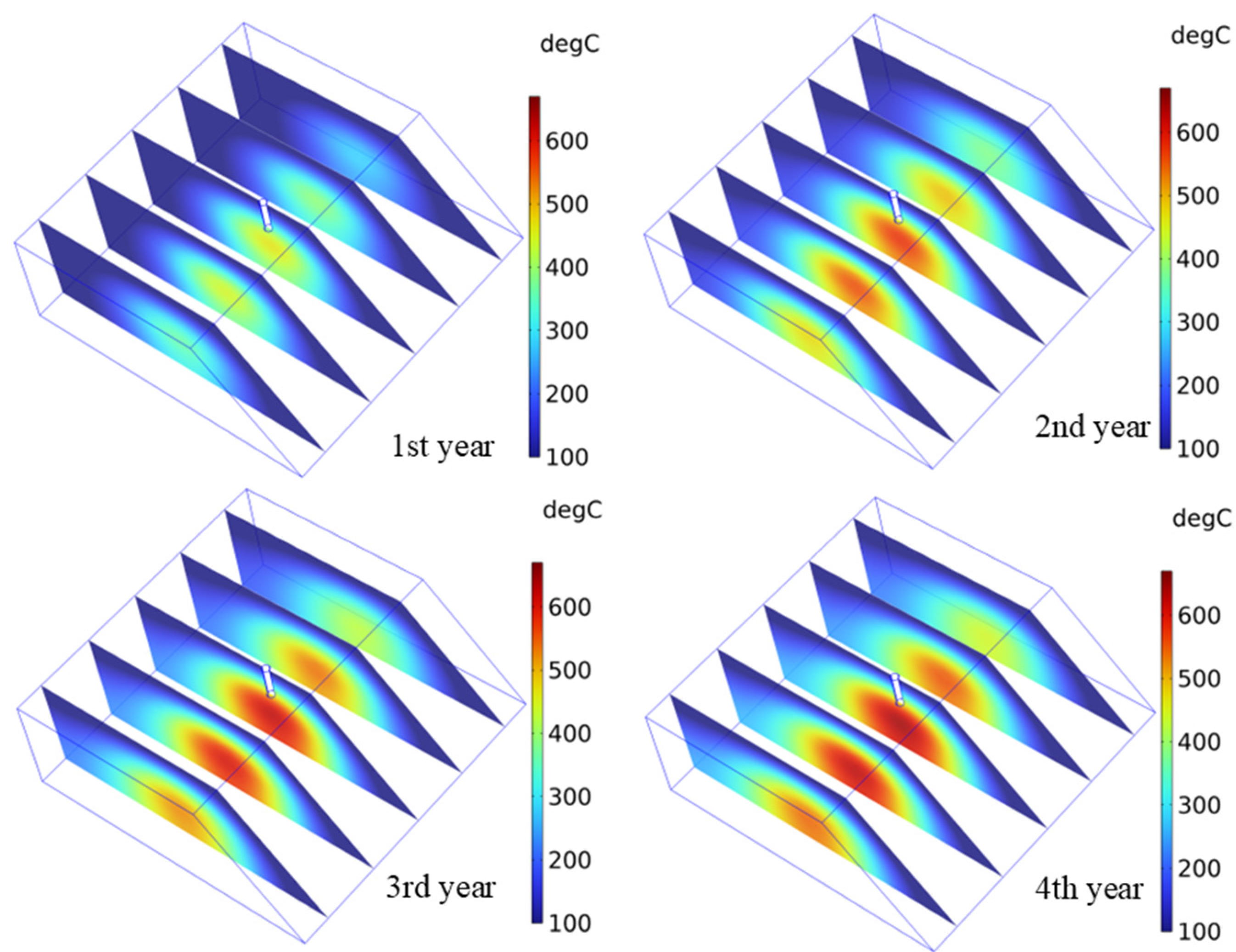
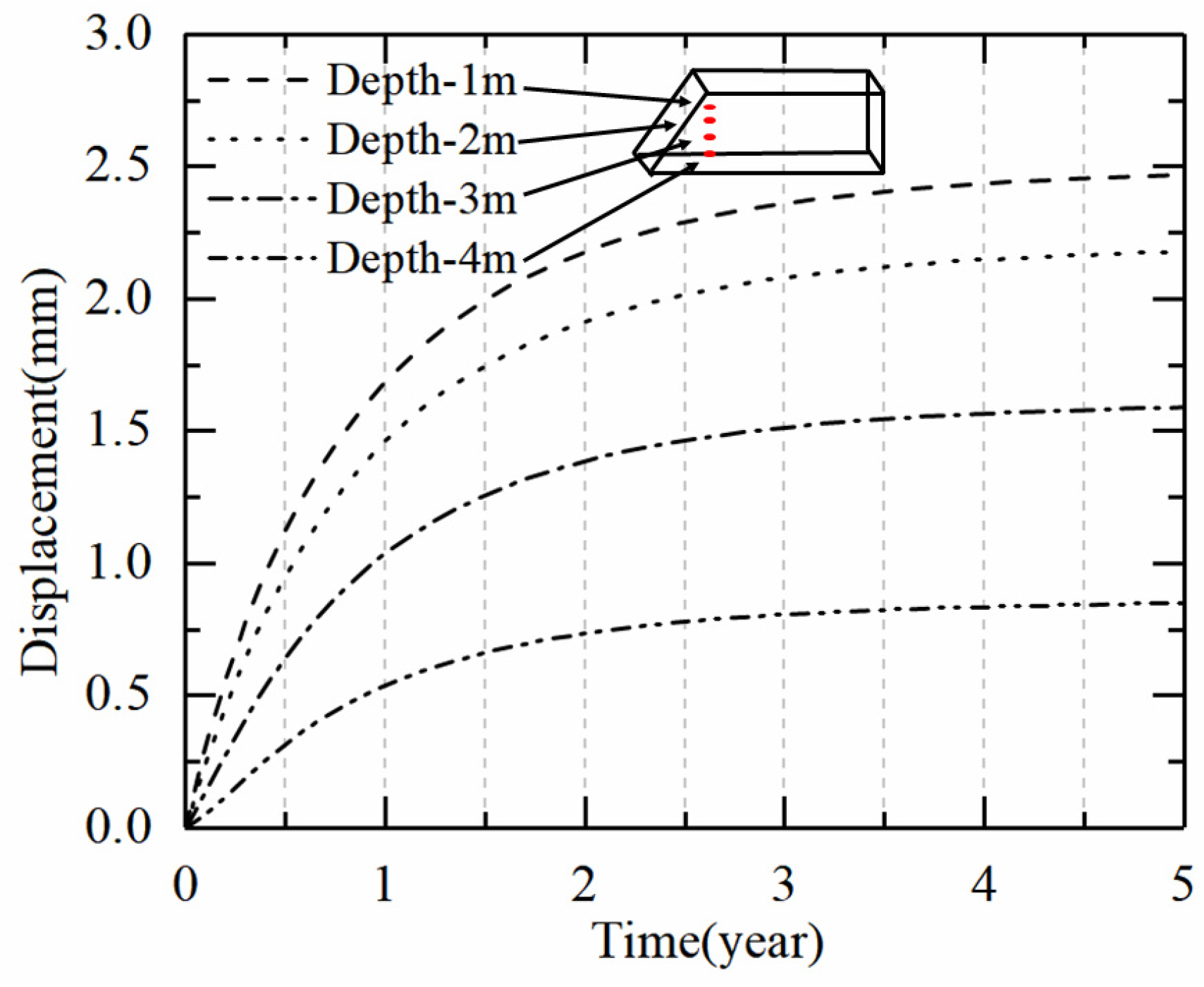
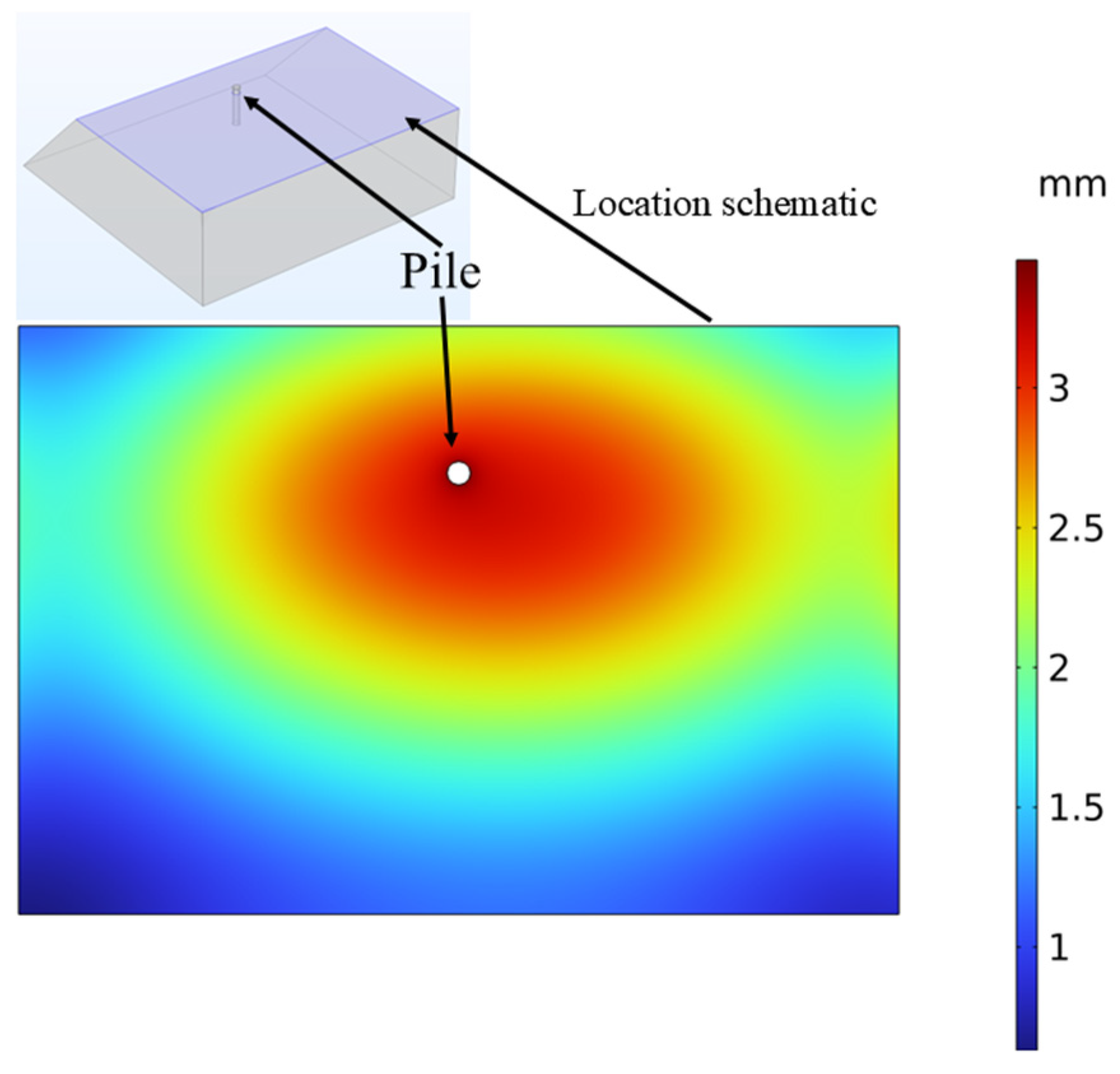
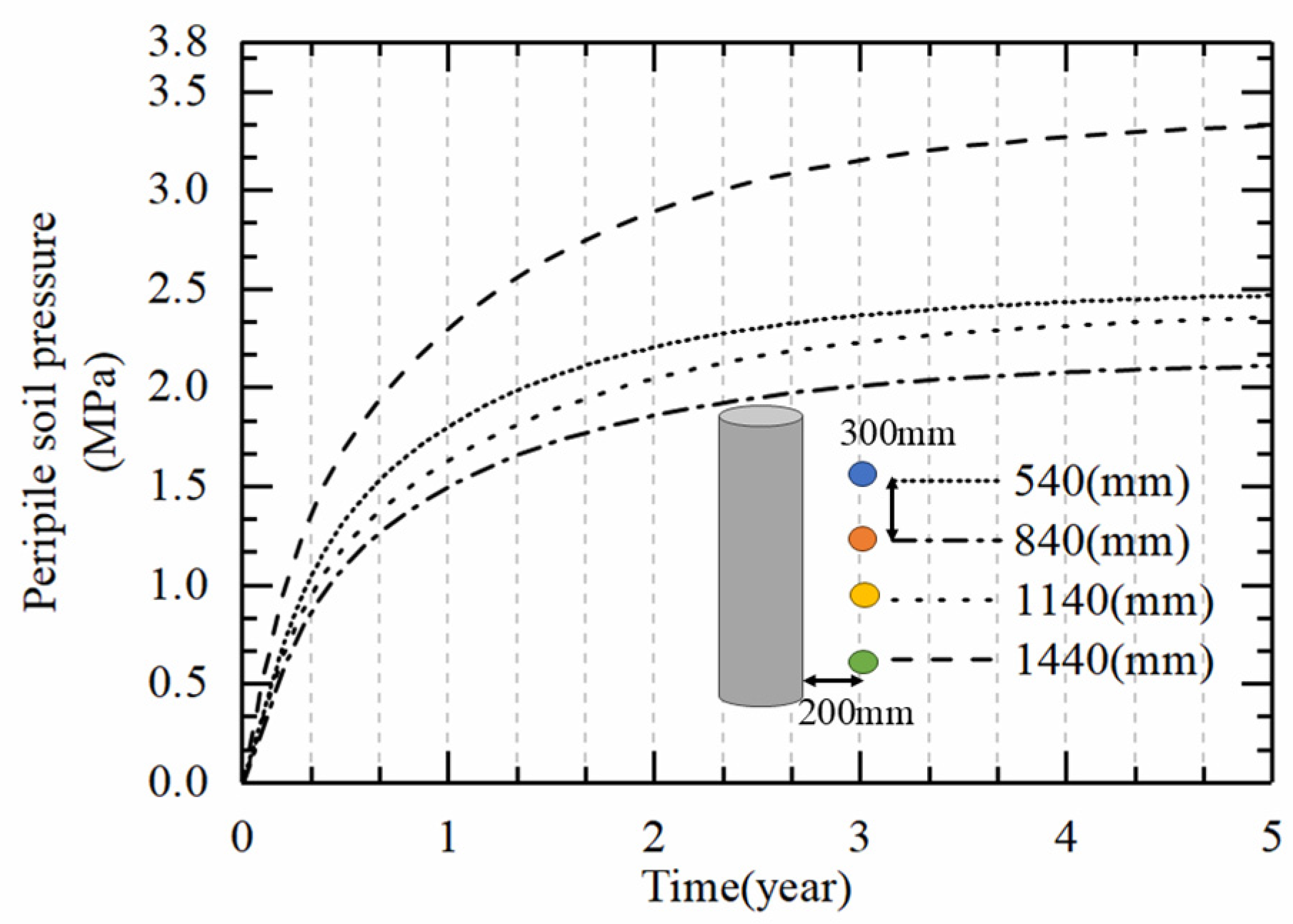

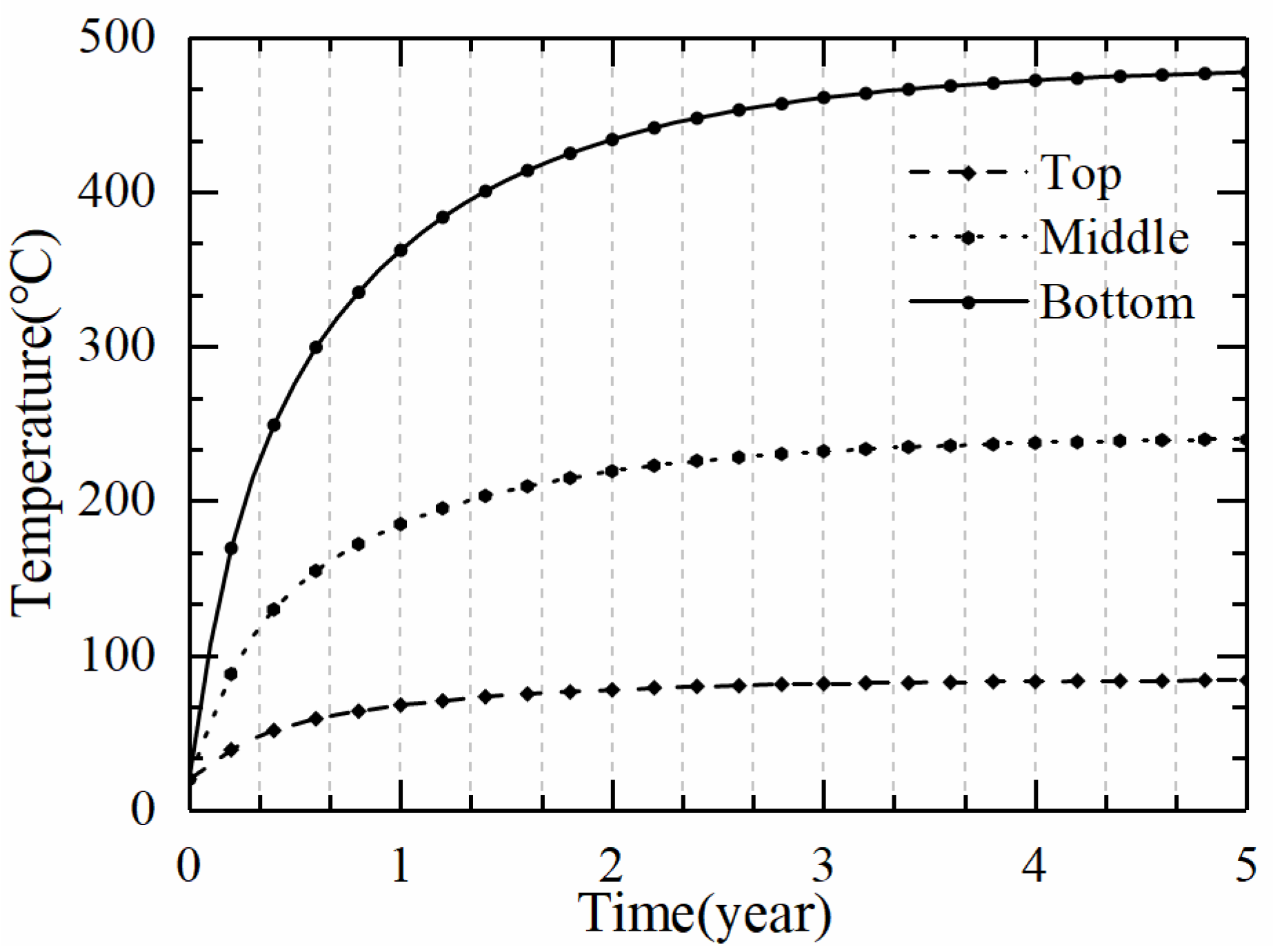

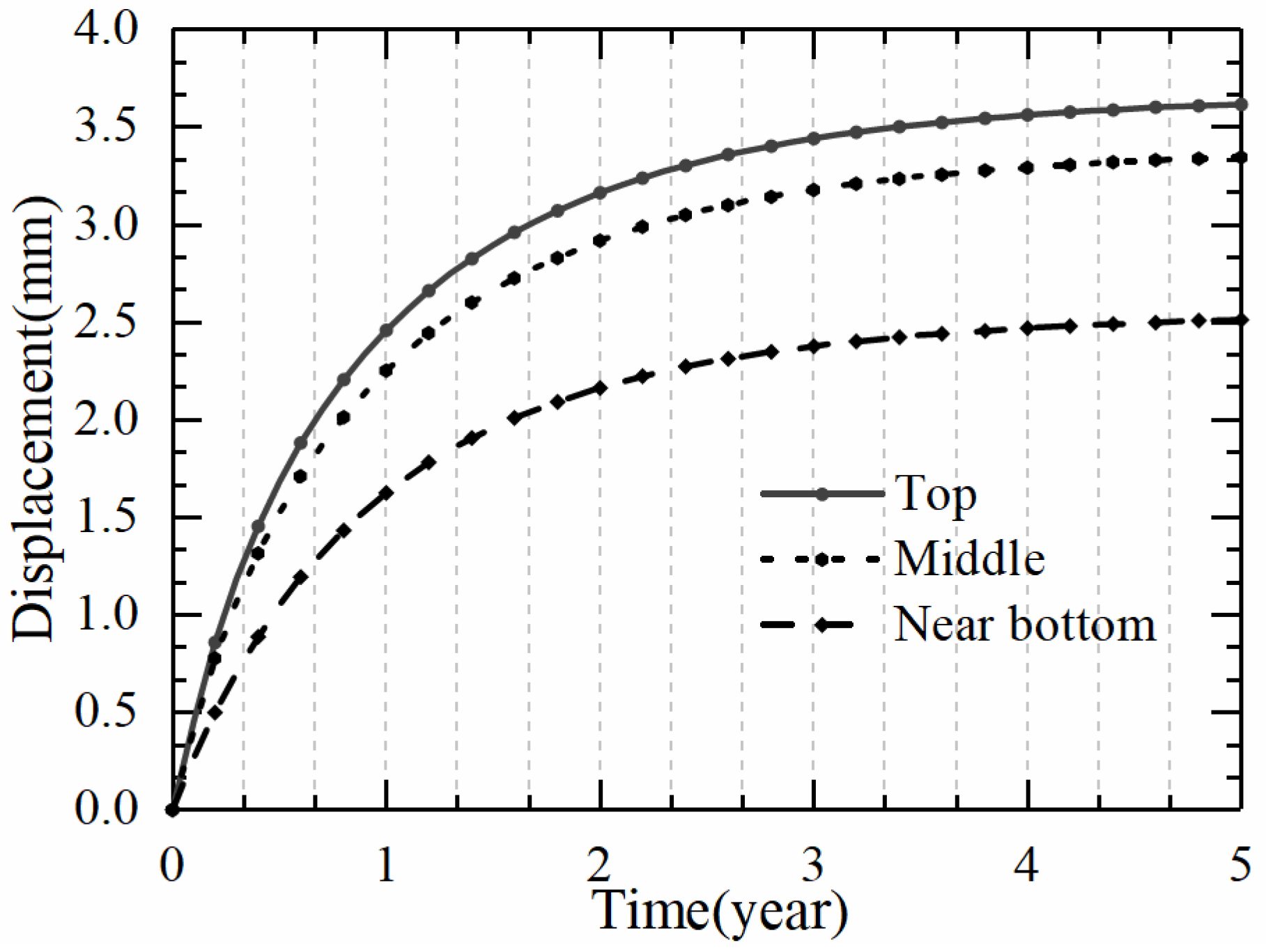

| Parameter Name | Parameter Symbol | Numerical Value (Units) |
|---|---|---|
| Initial wind speed | v0 | 2 m/s |
| Initial oxygen concentration | c0 | 9.375 mol/m3 |
| Barometric pressure | Pa | 1 atm |
| Indexing factor | A | 180 L/s |
| Air diffusion coefficient | D | 1.5 × 10−5 m2/s |
| Air density | ρg | 1.43 kg/m3 |
| Convection coefficient | h2 | 0.75 W/(m2∙K) |
| Activation energy | E | 50,000 J/mol |
| Convection coefficient | h | 0.75 W/(m2∙K) |
| Universal gas constant | R | 8.314 J/(mol∙K) |
| Time (Year) | Strains (×10−3) | ||
|---|---|---|---|
| Top | Middle | Near Bottom | |
| 0 | 0 | 0 | 0 |
| 1 | 0.495 | 0.204 | 2.317 |
| 2 | 0.599 | 0.241 | 2.803 |
| 3 | 0.638 | 0.256 | 2.988 |
| 4 | 0.654 | 0.263 | 3.066 |
| 5 | 0.662 | 0.266 | 3.102 |
Disclaimer/Publisher’s Note: The statements, opinions and data contained in all publications are solely those of the individual author(s) and contributor(s) and not of MDPI and/or the editor(s). MDPI and/or the editor(s) disclaim responsibility for any injury to people or property resulting from any ideas, methods, instructions or products referred to in the content. |
© 2025 by the authors. Licensee MDPI, Basel, Switzerland. This article is an open access article distributed under the terms and conditions of the Creative Commons Attribution (CC BY) license (https://creativecommons.org/licenses/by/4.0/).
Share and Cite
Zheng, W.; Lin, Y.; Xu, Z.; Ye, Z.; Wang, C. Study on the Impact of Spontaneous Combustion of Coal Gangue on Photovoltaic Pile Foundations and Surface Structures. Buildings 2025, 15, 1416. https://doi.org/10.3390/buildings15091416
Zheng W, Lin Y, Xu Z, Ye Z, Wang C. Study on the Impact of Spontaneous Combustion of Coal Gangue on Photovoltaic Pile Foundations and Surface Structures. Buildings. 2025; 15(9):1416. https://doi.org/10.3390/buildings15091416
Chicago/Turabian StyleZheng, Wenjin, Yiyang Lin, Zhanpeng Xu, Zhigang Ye, and Chenglong Wang. 2025. "Study on the Impact of Spontaneous Combustion of Coal Gangue on Photovoltaic Pile Foundations and Surface Structures" Buildings 15, no. 9: 1416. https://doi.org/10.3390/buildings15091416
APA StyleZheng, W., Lin, Y., Xu, Z., Ye, Z., & Wang, C. (2025). Study on the Impact of Spontaneous Combustion of Coal Gangue on Photovoltaic Pile Foundations and Surface Structures. Buildings, 15(9), 1416. https://doi.org/10.3390/buildings15091416





